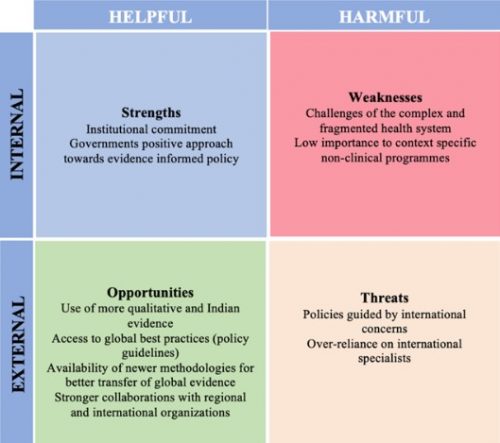Dr Eti Rajwar1 and Prof Sandy Oliver2
1Public Health Evidence South Asia, Prasanna School of Public Health, Manipal Academy of Higher Education, India
2EPPI Centre, Social Research Institute, University College London, UK
August 2023
“Change is inevitable, growth is optional!”– John C Maxwell
It is famously said that ‘Change is the only constant’ and it is the adaptation to this change that leads to growth and evolution. Over the years, we have witnessed many changes in health research that have led to huge accomplishments in the field of medical science and public health. Taking into account research findings before making decisions – evidence informed decision-making (EIDM) – is one such development. Another is systematically pooling the findings from multiple studies to create systematic reviews of research, a process also known as ‘evidence synthesis’. India’s history with evidence informed clinical decision-making dates back to the late 1990’s and since then, an increasing focus on systematic reviews to develop evidence-informed clinical guidelines has given evidence informed health decision making a strong foothold in India. Our research focuses on the potential for evidence informed policy decisions in India. We asked what has been achieved in terms of policy decisions and what might come next? To answer these questions, we studied Indian health policy documents to understand whether research evidence, specifically systematic review evidence, informed these health policies? This is what we found.
India has been using systematic review evidence to inform some high priority National Health Programme guidelines.
India has been using systematic review evidence, particularly for policies related to perinatal health and communicable diseases. These systematic reviews provided reliable information on policy options by comparing a range of diagnostic and treatment alternatives available for managing a public health problem (e.g. Tuberculosis). However, often missing in guidelines was a direct link between policy recommendations and the systematic review. We delved further to investigate why the use of systematic reviews was concentrated in a few programmes, and what opportunities there are to further advance evidence informed policymaking in Indian public health.
- How has citing systematic reviews in policy guidance grown?
In the late 1990s and early 2000’s, when evidence use for policy decisions was growing globally, donor funding for international priorities, such as HIV/AIDS, Tuberculosis, and mother and child health, was followed by systematic reviews appearing more frequently in official Indian guidelines. Growing national enthusiasm for evidence informed policy making, as seen by the establishment of new evidence synthesis centers (to produce systematic reviews) in India, may have also influenced increasing visibility of systematic reviews in Indian health guidelines from 2014 onwards, with noticeable spurts in 2016 and 2017, and a clear focus on evidence informed policy making in the 2017 National Health Policy.
- How is Indian research evidence informing these evidence-informed guidelines?
Health policies and guidelines drew on both international and Indian research evidence. Indian evidence largely explained the nature and scale of the health problems being addressed, while global evidence more often justified the policy options recommended. The global evidence often provided good estimates of treatment effects, while not necessarily taking into account how effects vary in particular contexts. India’s extrapulmonary tuberculosis or INDEX-TB guidelines, published by the central TB division of India, deftly mixed global and local Indian evidence to develop diagnostic and treatment policies.
- What sort of evidence informs these guidelines?
On exploring the data further, we found that most of the evidence informing health guidelines came from quantitative studies. These studies provided an approximation of the gravity of the health problem or a numerical estimate regarding a better policy option or solution. In contrast, qualitative evidence can help with understanding the underlying causes of problems, recognise why particular policy options perform well or poorly, or identify opportunities for local adaptation for better implementation. Yet, none of the guidelines drew on synthesis of qualitative research.
The way forward!
Based on our research findings, we listed factors we anticipate influencing India’s onward journey with evidence informed health policymaking. These factors include the health systems’ internal strengths and weaknesses and its external opportunities and threats, to create a SWOT analysis:
- Strengths: Institutional commitment and the government’s positive approach towards evidence-informed decision making will shape India’s progress.
- Weaknesses: Lack of a clear plan to address the challenges of a complex and fragmented health system, with little attention paid to the importance of context when developing specific non-clinical programmes will present barriers.
- Opportunities: Capitalizing on the ample opportunities such as, a) use of more qualitative and Indian evidence, particularly in non-clinical systematic reviews where context is an especially important influence; b) access to global best practices (policy guidelines) that establish closer links between recommendations and underpinning evidence; c) availability of newer methodologies for better transfer of global evidence about policy options to local settings; d) procedures that routinely consider evidence when developing policy in India; e) and stronger collaborations with regional and international organizations for greater efficiency and balance in using global and Indian evidence. Appropriate use of these opportunities would help in achieving more consistent use of evidence across programmes and will increase the visibility of science and model the use of evidence in policy development.
- Threats: Over reliance on international concerns and international specialists, at the expense of India’s priorities and expertise.

* EIDM=Evidence Informed Decision Making; External=External factors; Internal=Internal factors
Figure 1: SWOT Analysis of factors influencing evidence informed health policymaking in India
To conclude, over the years, India has already achieved remarkable success with evidence informed health decision making. With good use of its inherent strengths and opportunities, the country is sitting on another brink of change to define the future of evidence informed policy making in the country.
Acknowledgement: We would like to thank the Scheme for Promotion of Academic and Research Collaboration (SPARC), Ministry of Human Resource Development, Government of India, who funded the original research (grant number 1478).











